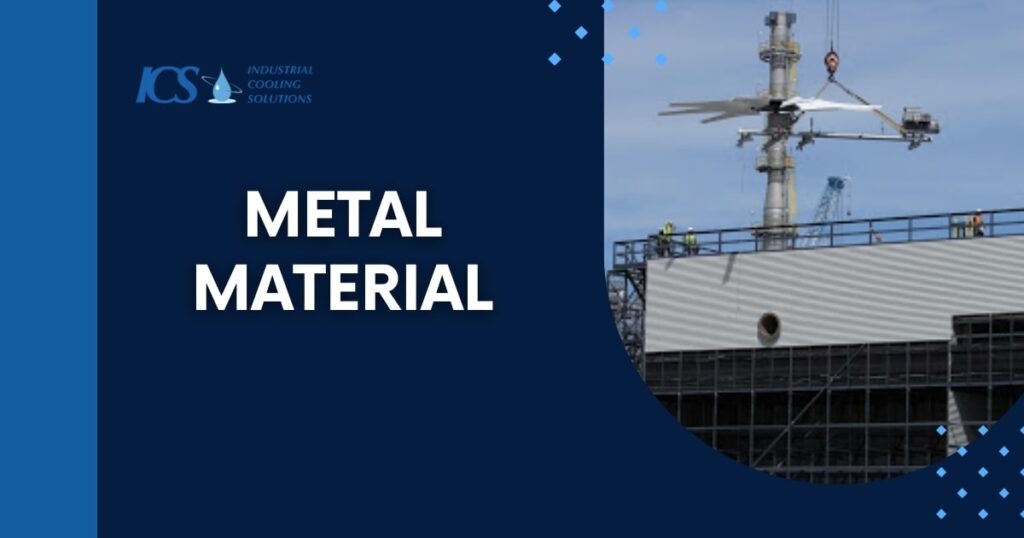Industrial processes use cooling towers to safely release heat from their equipment and machines. Choosing the right materials for cooling tower construction is also very important in order to guarantee the effectiveness, durability and safety of the entire system. This article discussed the importance of the material selection in cooling towers.
Cooling Tower Structure

What is cooling towers?
Cooling towers are heat removal devices that remove heat from the building. Cooling tower use water evaporation to remove the excess heat.
Components of cooling towers
Cooling towers which are important to the system efficiency, heat exchange and water cooling have several parts and components installed.
Cooling tower components include:
- Fill media
- Drift eliminators
- Fans
- Distributor
- Cold water tank
Each subsystem performs completely different functions, from the creation of water-air contact to the prevention of water misuse (or discharge) and perfect air circulation.
The choice of material for these components is among the most important factors which directly influences parameters such as durability, corrosion resistance and overall efficiency.
Correct material selection for each element verifies long service life, integrity, and efficiency of the cooling tower system.
What’s the best material for cooling tower?

Metal Materials:

Frequently metals such as stainless steel and galvanized steel are the common metals employed in the manufacture of the cooling towers due to their endurance at high temperatures.
For example, stainless steel exhibits excellent corrosion resistance and can withstand harsh environmental conditions, making it suitable for long-term use.
However, it is metal materials that have their own drawbacks, for example they are corrosive and that is especially in the case of the environments where high chloride content is present.
Apart from this, metal materials also are more expensive compared to their plastic counterparts in terms of cost.
Plastic Materials:
FRP, a type of plastic material which is fiberglass reinforced plastic, is being increasingly used in cooling tower buildings.
FRP provides very good corrosion resistance so it is definitely the best option when the water severely contains chlorides.
Furthermore, the plastic materials are light but the light version of them are still transportable and applicable easily. Nevertheless, plastics may get affected by UV degradation gradually but metals have superior UV isolation and are less susceptible to them.
Also, plastics don’t take high temperatures well which makes them not suitable for being used in hot working conditions.
The major disadvantage both the choice of plastics for cooling tower applications in terms of cost effectiveness is their price which is the preferred material in many types of applications.
Suitability for High Chloride Content Water

Chlorine-rich water is one of the main features that makes the choice of cooling tower materials more complicated.
The stainless steel, for instance, among all the metal materials, is less vulnerable to chlorides but might suffer from corrosion too with time if not properly maintained. Nevertheless, unlike aluminium alloys, FRP plastic materials like fiberglass reinforced plastic (FRP) have a good corrosion resistance which makes them desirable to use in a high chloride environment.
The FRP cooling tower component has been proven effective in industries where chloride content in water is high, including coastal power plants and chemical processing plants.
This highlights the efficacy of plastic compounds in providing for the corrosion resistance in the worst water conditions.
Risk of Corrosion
Corrosion in cooling towers is dependable on a number of factors for example the quality of the water, chemicals and environmental condition they are exposed to.
Metals tend to corrode from chemical reactions which result from water and environmental contaminants, whereas plastic materials are generally more resistant.
Metals overcome corrosion risks through application of coatings, alloys, and sacrificial anodes while plastics have corrosion resistance by nature.
Techniques like frequent clean up, pH monitoring and corrosion inhibitors are used as maintenance procedures which reduce wear and tear involving metal and non-metal components of the towers, thus enabling them to serve for long periods of time.
Routine surveillance, and preventative maintenance are essential to avoid corrosion breakdown.
Cold Water Basin

The cold water basin is a facet of cooling towers that enables the process of heat exchange.
Considering the resistance to corrosion, cost and maintenance ease, when compared, choose between stainless steel and FRP for the basin.
Stainless steel is more durable, but it may be more costly while FRP is corrosion resistant and cheaper.
Conclusion
In conclusion, the choice between metal and plastic materials for cooling tower construction depends on various factors such as corrosion resistance, cost, and suitability for specific water conditions.
While both options have their advantages, careful consideration of application is essential to ensure optimal performance, quality and longevity of operation.

